The 1950s may have been the decade of I Love Lucy, The Honeymooners, and Leave It to Beaver, but Sid, Cecil, and Tincy definitely were no Ricky, Ralph, and Mr. Cleaver.
In the 1950s Cecil Green and Tincy Eggleston were two of the darkest of the dark lords of Cowtown’s underworld.
Green was only fourteen when he was sentenced to a year in the Texas State Training School at Gatesville for theft. Thereafter he compiled an impressive resume: arrests for assault, burglary, robbery, safecracking, and murder. He had been a suspect in the car-bomb murders of gambler Herbert (“The Cat”) Noble (1951) and his wife Mildred (1949).
Tincy was first arrested at age seventeen. His resume included arrests for burglary, robbery, bootlegging, extortion, illegal gambling, assault with intent to murder, and murder. Eggleston had been a suspect in the car-bomb murders of racketeer Nelson Harris, his wife, and her unborn child in 1950.
Both Green and Tincy had been indicted for the murder of wealthy oilman William P. Clark in 1953.
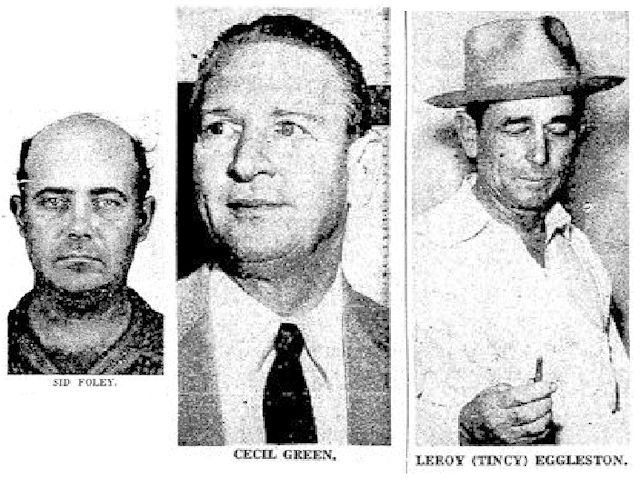 Our third musketeer, Sid Foley, compared with Green and Eggleston, was an underworld underachiever: mostly burglary, check violations. To make a buck, Foley eventually was reduced to buying women’s stoles of dyed rabbit fur for $18.50 a dozen and selling them as “hot” expensive stoles for as much as $100 each.
Our third musketeer, Sid Foley, compared with Green and Eggleston, was an underworld underachiever: mostly burglary, check violations. To make a buck, Foley eventually was reduced to buying women’s stoles of dyed rabbit fur for $18.50 a dozen and selling them as “hot” expensive stoles for as much as $100 each.
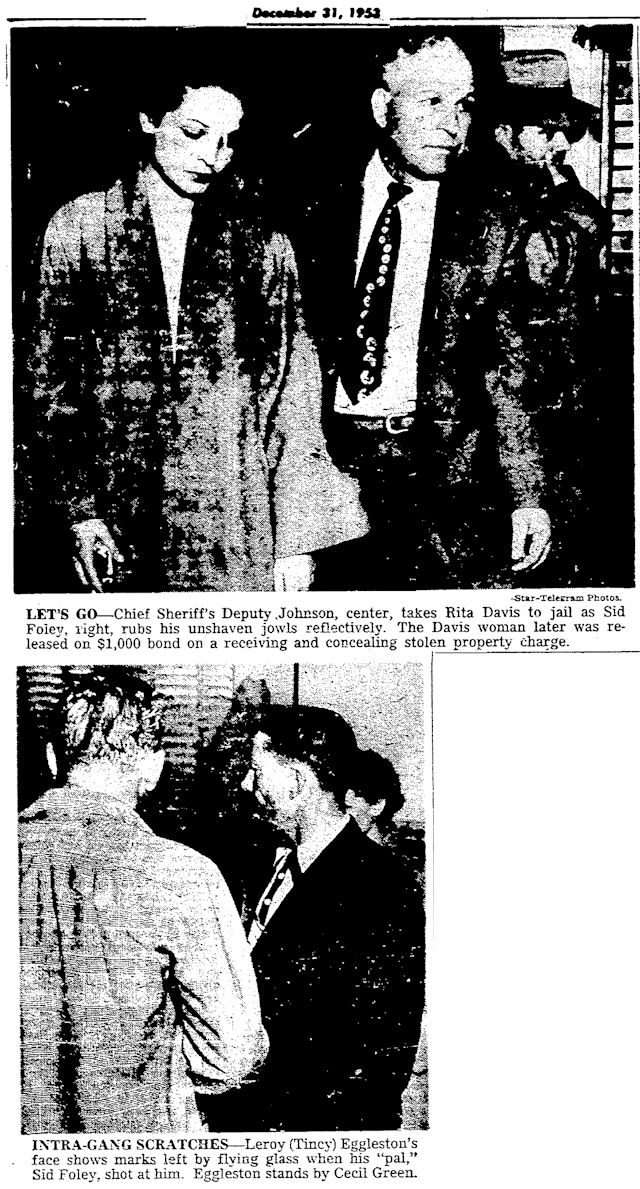
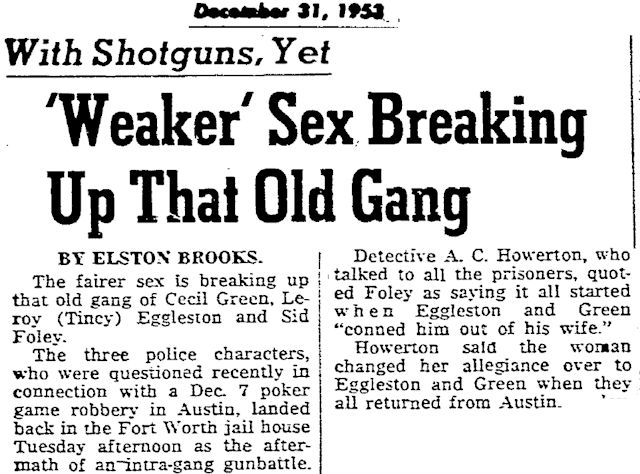 But Sid Foley, bless his heart, did have his pride.
But Sid Foley, bless his heart, did have his pride.
On the last day of 1953 twenty-three-year-old police reporter and future Star-Telegram entertainment columnist Elston Brooks reported on the lighter side of these three dark lords:
Green, Tincy, and Foley had robbed participants of a poker game in Austin. After the robbery, Fort Worth police detective A. C. Howerton said, Foley’s wife “changed her allegiance” from her husband to Green and Tincy.
That made Sid so sad, see? Sure.
Later Sid Foley saw his wife in a car with Green and Tincy on Jacksboro Highway and “surprised” them—with a pistol and a shotgun. Foley fired two shots into the car with his pistol but was “unable to get his shotgun into action,” Howerton said. Nonetheless, Foley gave Tincy a close shave: Tincy’s face was cut by flying car window glass. Then the menage à mobster sped away, Green and Tincy shooting at Foley as they fled.
Soon after, Mrs. Foley and Rita Davis, Green’s girlfriend, were “apartment hunting” on the North Side when Sid Foley saw them sitting in a parked car. The women were reading newspaper classified ads when Sid Foley jerked his wife out of the car.
That’s when Rita Davis grabbed her shotgun and began chasing Sid Foley down Central Avenue on foot. Residents of Central Avenue telephoned the police. Mrs. Foley drove away in Sid’s car. Rita eventually gave up the chase.
Police picked up Rita Davis and boyfriend Green.
Tincy and Sid Foley turned themselves in to police.
Rita Davis was charged with receiving and concealing stolen property—a diamond ring taken in the Austin poker game robbery. At the police station the four were “paraded” at all roll calls so that patrolmen would recognize the four. Rita Davis was freed on bond. The three men were told to get out of town or be jailed as vagrants.
Use your time well, musketeers. Two of you have two years left to live. One of you has four years.
Fast-forward to 1955. In April gambler Edell Evans disappeared—never a good sign in his line of work. Police found blood on the front seat of his abandoned Cadillac. A few months later police, acting on a tip, found Evans’s body in a shallow grave not far from Jacksboro Highway. Green and Tincy still had not been tried for the William Clark murder. They were free on bond. Police Chief Cato Hightower said Green and Tincy, who ran an extortion racket, might have killed Evans to increase their reputation as bad hombres to be feared and not crossed.
Ann Arnold in Gamblers & Gangsters has a different theory: Edell Evans was the victim of market economics. He had hired Green and Tincy to kill a minor competitor in prostitution. As Green and Tincy were about to pull the trigger and fulfill their contract, the intended victim asked who had paid them. Green said Evans was the contractor. The intended victim asked how much Tincy and Green were being paid.
“Fifteen thousand up front and another fifteen thousand when the job is finished.”
The intended victim offered to pay Tincy and Green $20,000 to kill Evans instead, reminding Tincy and Green that they already had the $15,000 up-front money and would come out $5,000 ahead.
Deal.
Green and Tincy reported back to Evans that they had killed their victim. Evans wanted proof. So, Green and Tincy told Evans they would take him to the body. As they were driving, Tincy, in the back seat, shot Evans. Tincy and Green buried him in a shallow grave.
Police suspected Green and Tincy in the murder of Evans, but in the Cowtown underworld the short fuse of revenge often was quicker than the long arm of the law:
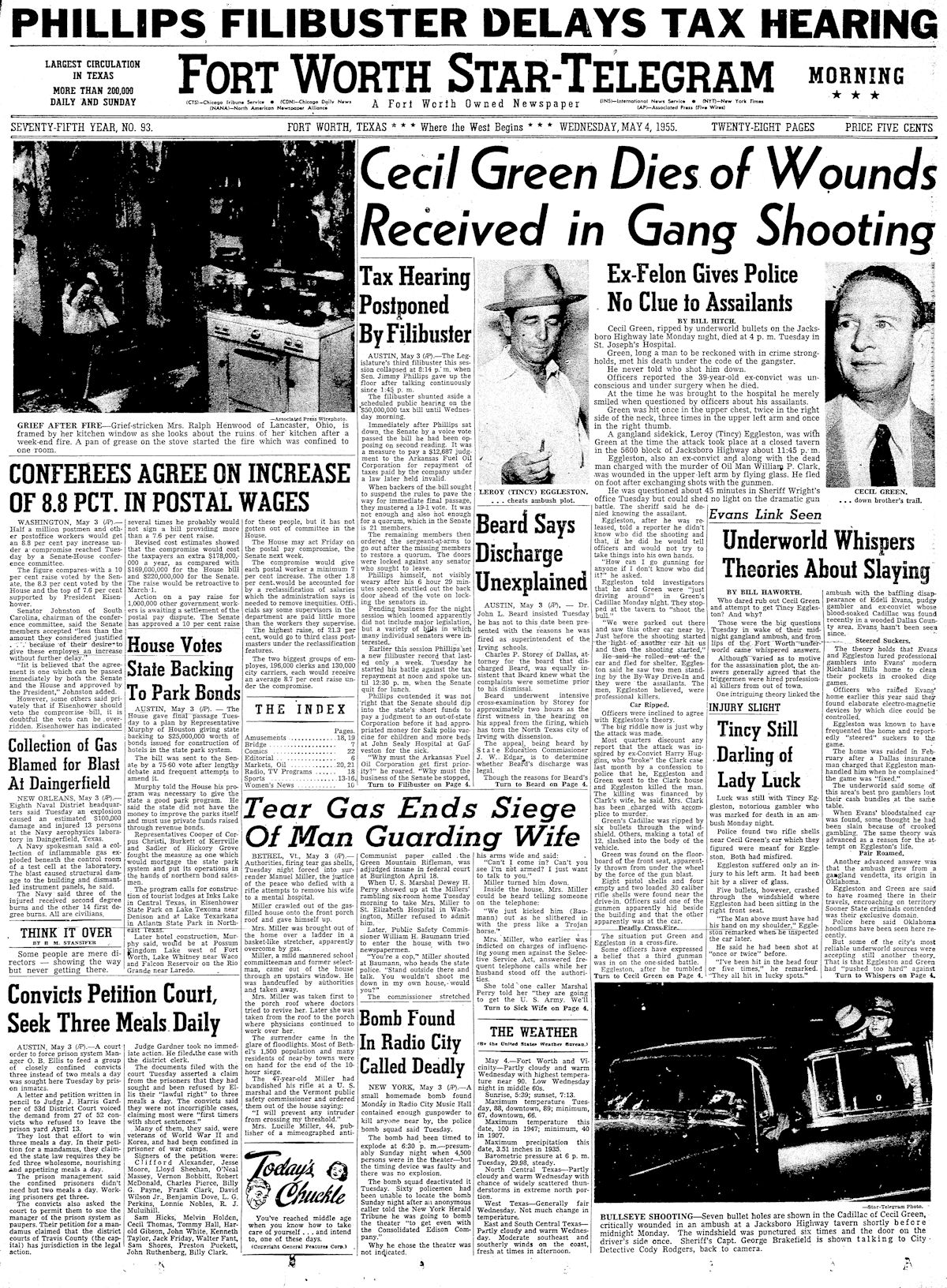 A month later Cecil Green was killed in a drive-by shooting as he and Tincy sat in a car at the By-Way Drive-In on Jacksboro Highway. The By-Way was owned by the sister of hitman Gene Paul Norris. Police Chief Hightower called Norris a “madman.” (Coincidentally, if you’re keeping score, by then Rita Davis was Green’s former girlfriend and Norris’s current wife.) During the By-Way drive-by Green was hit seven times. And the assassin gave Tincy another close shave: Just as when Sid Foley had shot at Green and Tincy and Mrs. Foley in 1953, Tincy suffered only minor injuries from flying car window glass. Clearly Green, not Tincy, had been the target at the By-Way. Hmmm. Or had Tincy used Green as a human shield? Hmmm. Or had Tincy set up Green? Tincy claimed he had emptied his pistol at the fleeing car. Did he aim wide?
A month later Cecil Green was killed in a drive-by shooting as he and Tincy sat in a car at the By-Way Drive-In on Jacksboro Highway. The By-Way was owned by the sister of hitman Gene Paul Norris. Police Chief Hightower called Norris a “madman.” (Coincidentally, if you’re keeping score, by then Rita Davis was Green’s former girlfriend and Norris’s current wife.) During the By-Way drive-by Green was hit seven times. And the assassin gave Tincy another close shave: Just as when Sid Foley had shot at Green and Tincy and Mrs. Foley in 1953, Tincy suffered only minor injuries from flying car window glass. Clearly Green, not Tincy, had been the target at the By-Way. Hmmm. Or had Tincy used Green as a human shield? Hmmm. Or had Tincy set up Green? Tincy claimed he had emptied his pistol at the fleeing car. Did he aim wide?
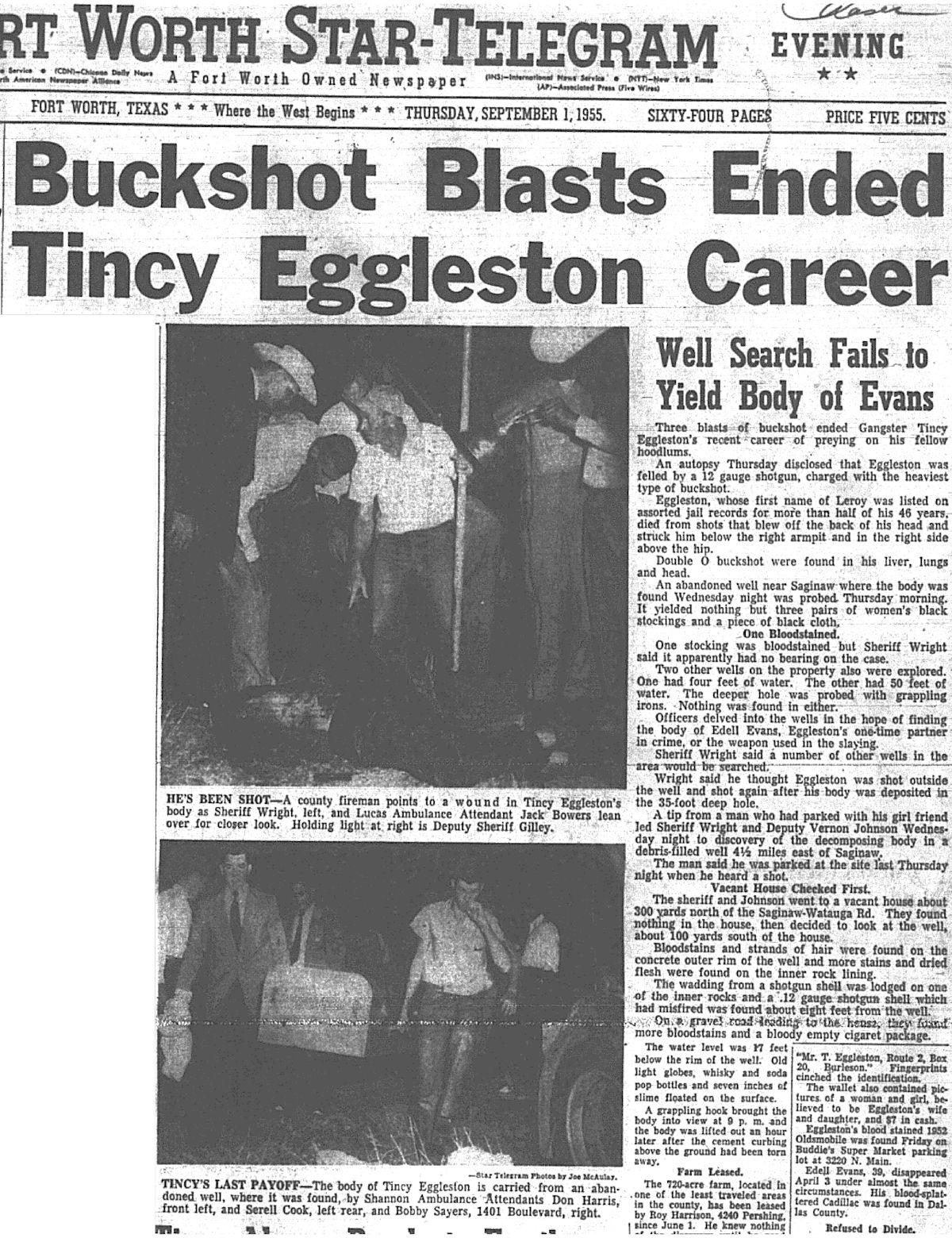 Then it was Tincy’s turn. On August 25, 1955 Eggleston left his house and didn’t come home that night.
Then it was Tincy’s turn. On August 25, 1955 Eggleston left his house and didn’t come home that night.
On August 31 he turned up—in an abandoned well near Saginaw. He had been shotgunned to death.
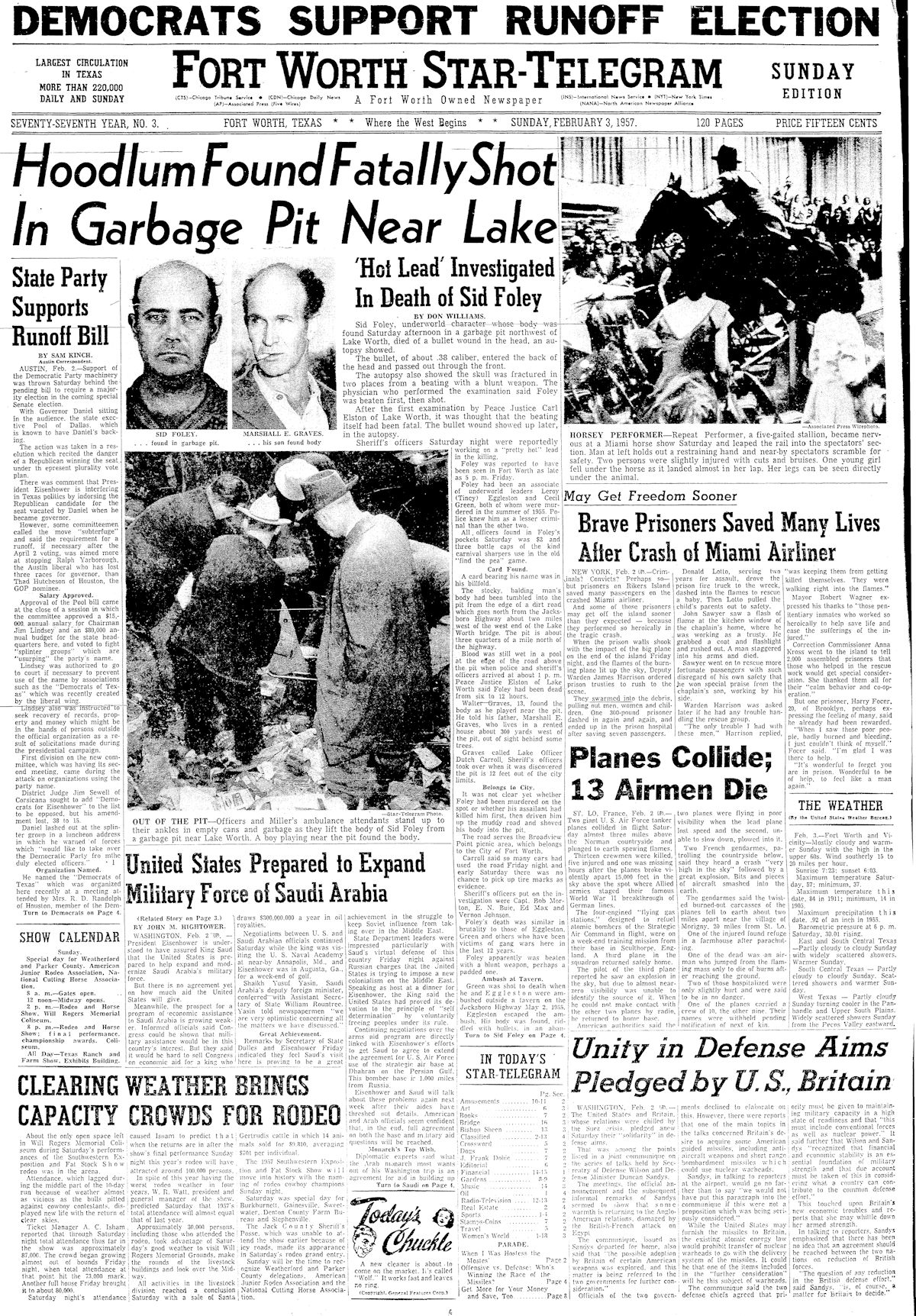 Fast-forward two years. On February 2, 1957 the body of our last musketeer of 1953, Sid Foley, was found in a dump ground near Lake Worth. The Press called the dump ground “gangland’s Boot Hill” because of its popularity as a gangster graveyard. After all, the dump ground was secluded, and it was convenient—just three-quarters of a mile west of the underworld’s home base: Jacksboro Highway.
Fast-forward two years. On February 2, 1957 the body of our last musketeer of 1953, Sid Foley, was found in a dump ground near Lake Worth. The Press called the dump ground “gangland’s Boot Hill” because of its popularity as a gangster graveyard. After all, the dump ground was secluded, and it was convenient—just three-quarters of a mile west of the underworld’s home base: Jacksboro Highway.
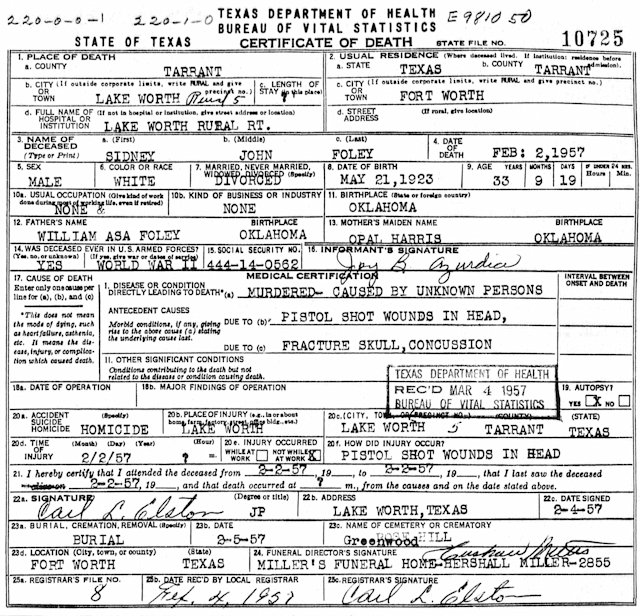 Foley had been beaten and shot in the back of the head. The Star-Telegram reported that the valuables found on Foley consisted of $2 and three bottle caps “of the kind carnival sharpers use in the old ‘find the pea’ game.”
Foley had been beaten and shot in the back of the head. The Star-Telegram reported that the valuables found on Foley consisted of $2 and three bottle caps “of the kind carnival sharpers use in the old ‘find the pea’ game.”
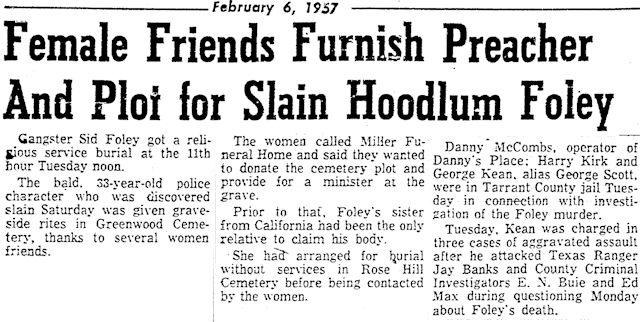 Sid Foley may have been “conned out of his wife” by Cecil Green and Tincy Eggleston in 1953, but after his death the Star-Telegram said the “bald, 33-year-old police character” had been “noted as a ladies’ man.”
Sid Foley may have been “conned out of his wife” by Cecil Green and Tincy Eggleston in 1953, but after his death the Star-Telegram said the “bald, 33-year-old police character” had been “noted as a ladies’ man.”
Indeed, after his sister in California was the only person to claim his body and planned to have him buried without a funeral, “several women friends” chipped in to pay for his cemetery plot and to provide a minister at the grave.
Meanwhile, Danny McComb, police character and operator of a tavern on Jacksboro Highway frequented by gangsters, was jailed and questioned in the Foley murder. McComb’s arrest record included burglary, aggravated assault, assault with a deadly weapon, kidnapping, pandering, passing bad checks, jimmying slot machines, and murder.
Also jailed and questioned was hoodlum George Kean. Kean took exception to the line of questioning by police and was charged with assaulting the three lawmen who were questioning him.
 This WBAP-TV Texas News script adds that before Sid Foley’s body was found he had been seen at McComb’s tavern, where George Kean worked as a bouncer. McComb was arrested for possession of gaming equipment.
This WBAP-TV Texas News script adds that before Sid Foley’s body was found he had been seen at McComb’s tavern, where George Kean worked as a bouncer. McComb was arrested for possession of gaming equipment.
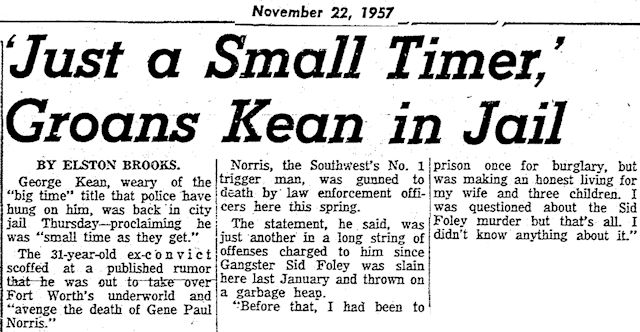 George Kean told Elston Brooks that he was “small time” and denied a published rumor that he was out to take over the local underworld and avenge the killing of Gene Paul Norris by lawmen earlier in 1957. Kean claimed to know nothing about the murder of Sid Foley.
George Kean told Elston Brooks that he was “small time” and denied a published rumor that he was out to take over the local underworld and avenge the killing of Gene Paul Norris by lawmen earlier in 1957. Kean claimed to know nothing about the murder of Sid Foley.
 With the deaths of Foley, Eggleston, and Green, police were without three of their usual suspects in 1958 after a “pack” of masked bandits stormed a family at a house on Clayton Road West and took $300 in cash. The Star-Telegram said Foley, Eggleston, and Green had always been among the first questioned by police about such robberies.
With the deaths of Foley, Eggleston, and Green, police were without three of their usual suspects in 1958 after a “pack” of masked bandits stormed a family at a house on Clayton Road West and took $300 in cash. The Star-Telegram said Foley, Eggleston, and Green had always been among the first questioned by police about such robberies.
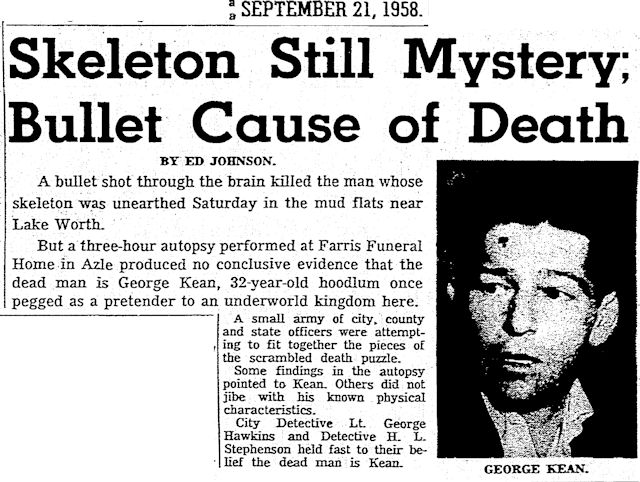 In September 1958 a skeleton was found near Lake Worth. Some police investigators thought the remains were those of George Kean, who had been questioned in the killing of Sid Foley.
In September 1958 a skeleton was found near Lake Worth. Some police investigators thought the remains were those of George Kean, who had been questioned in the killing of Sid Foley.
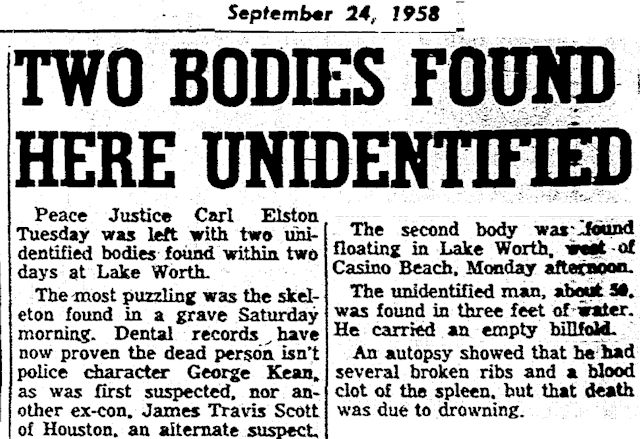 But dental records showed that the skeleton was not that of George Kean.
But dental records showed that the skeleton was not that of George Kean.
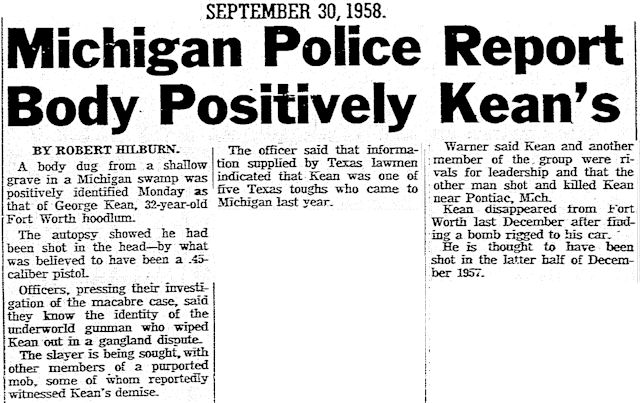 A week later investigators in Michigan, acting on a tip, uncovered the body of George Kean in a shallow grave in a marsh. The body was positively identified. The Star-Telegram reported that Kean had left Fort Worth in December 1957 after finding a bomb rigged to his car.
A week later investigators in Michigan, acting on a tip, uncovered the body of George Kean in a shallow grave in a marsh. The body was positively identified. The Star-Telegram reported that Kean had left Fort Worth in December 1957 after finding a bomb rigged to his car.
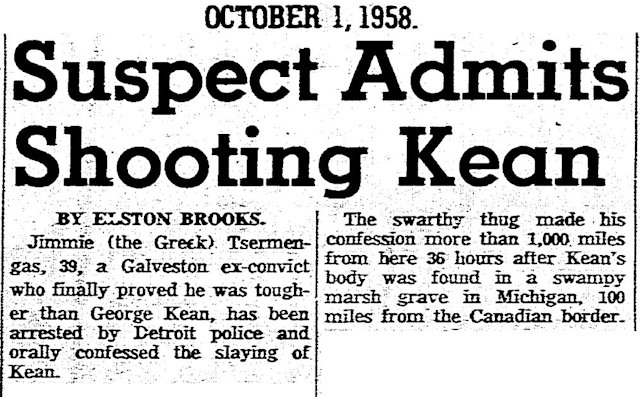 In October 1958 ex-convict Jimmy (“the Greek”) Tsermengas confessed to killing George Kean and burying his body in the marsh in Michigan. Tsermengas, George Kean, and Danny McComb had left Texas for greener pastures in Michigan, where they were not known. While burglarizing a building, they were surprised by two policemen. Somehow the hoods disarmed the officers and handcuffed them to a tree. Kean voted to kill the officers, but Tsermengas overruled him. Later at their hideout Kean got drunk and became belligerent, boasting that he was the “toughest.” Tsermengas and McComb tried to take a pistol away from Kean. The gun discharged, shooting Kean in the head.
In October 1958 ex-convict Jimmy (“the Greek”) Tsermengas confessed to killing George Kean and burying his body in the marsh in Michigan. Tsermengas, George Kean, and Danny McComb had left Texas for greener pastures in Michigan, where they were not known. While burglarizing a building, they were surprised by two policemen. Somehow the hoods disarmed the officers and handcuffed them to a tree. Kean voted to kill the officers, but Tsermengas overruled him. Later at their hideout Kean got drunk and became belligerent, boasting that he was the “toughest.” Tsermengas and McComb tried to take a pistol away from Kean. The gun discharged, shooting Kean in the head.
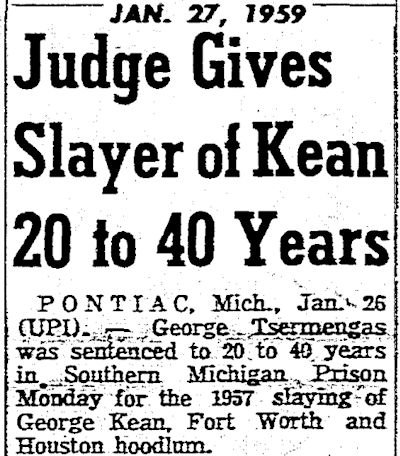 Tsermengas was sentenced to twenty to forty years in prison for killing Kean.
Tsermengas was sentenced to twenty to forty years in prison for killing Kean.
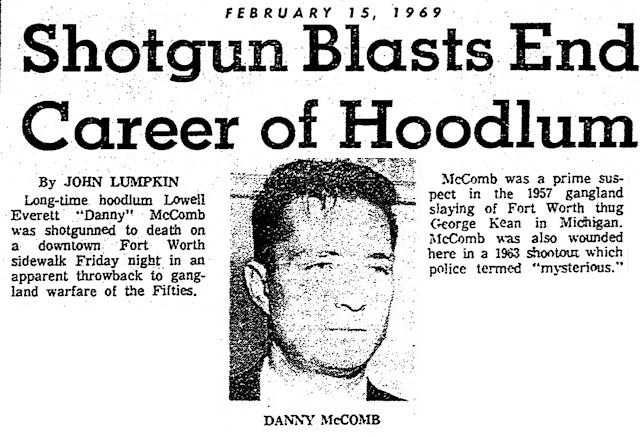 A few months later Danny McComb, who had been questioned in the killing of Sid Foley and was a suspect in the murder of George Kean, was shotgunned after leaving a nightclub on Burnett Street downtown.
A few months later Danny McComb, who had been questioned in the killing of Sid Foley and was a suspect in the murder of George Kean, was shotgunned after leaving a nightclub on Burnett Street downtown.
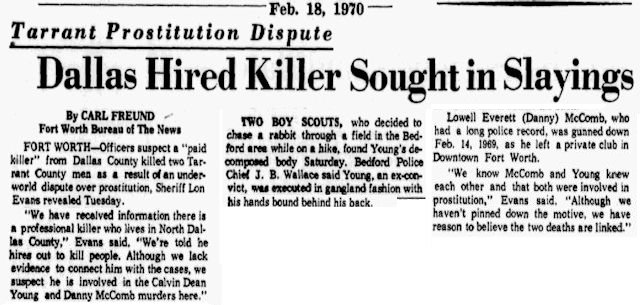 Tarrant County Sheriff Lon Evans in 1970 said an unnamed Dallas County hitman may have killed Danny McComb—along with Calvin Dean Young—“as a result of an underworld dispute over prostitution.”
Tarrant County Sheriff Lon Evans in 1970 said an unnamed Dallas County hitman may have killed Danny McComb—along with Calvin Dean Young—“as a result of an underworld dispute over prostitution.”
I can find no indication that anyone was ever convicted for McComb’s killing.
Whew. Here are the body count and conviction count since we were introduced to the three musketeers, Rita Davis, and Mrs. Foley in 1953: five murders, one conviction. That ratio is typical. The murders of most of the dark lords of Cowtown’s underworld remain unanswered questions.
And, of course, the other unanswered question is this:
Did Rita Davis and Mrs. Foley ever find the perfect apartment?






Danny was a good guy but it was Eugene Lucas that killed Calvin young. Danny was fair to all that were fair to him
Thank you for the information. My Aunt left me an intriguing story of her time as a madam working for men associated with the Dallas underworld in the 1950’s. She goes into great detail about setting up shop running the hoses the payoffs and share one adventure where the boys go into Alabama to break into a safe and survive being shot up with machine guns. She married a Tommy Pate & then a Nick Cassio and was involved with JR Todd (of the Warren Commission/Jack Ruby testimony) Nick was noted in a newspaper article as tied to Cecil & Tincy. Weird fact Tommy Pate Dallas underworld was 1st cousins with the Reporter Sam Pate First one to call out over the airwaves “Something, I Repeat Something has happened in the motorcade” when Kennedy was shot I find that curious and not sure anyone else but that together I was just researching and put two & Two together.
A coincidence: I have spent the last week researching a blog post about an obscure 19-year-old woman’s ties to other local and nonlocal criminals, including Cecil Green and from Green to Nick Cascio. I probably won’t use Cascio, but below are my notes so far. There is a LOT of info online about this subject, but I was confining my research to six or fewer connections to this Fort Worth woman. I also probably will use Casten and Lois Green. Have e-mailed you a (truncated) clip on Cecil Green and Cascio.
—-
In 1959, Sheriff Decker reported that past associates of [R. D.] Matthews are Hollis de Lois Green, Jettie Bass, Nick Cascio, James Robert Todd and Angelo Thomas Casten, who had been a member of Lois Green’s gang.
Nick cascio
a government committee questioned him about his source of income. He said he was a ‘self-employed speculator’ and let it go at that.
A newspaper reporter later asked him what he meant.
“I’m always speculating whether a safe is going to have any money in it or not,” Cascio reportedly said.
UPI: “One of the last old-time safecrackers in Dallas and one of the more notorious criminals in the Southwest,”
he was arrested more than 60 times during a career that spanned 30 years
Curios about any info on the supposed “madam.” My mother was also involved with Nick Cascio.
I am the granddaughter of “Danny.” I am 46 now and would like some more info. I mainly would like pictures.
Warmly,
Stacey Werner
Ms. Werner, my research, done a few years ago, was confined to newspapers. I don’t have any information beyond what is in the blog post. But the Star-Telegram archives are available online through the Fort Worth public library to card-holders. I have e-mailed four clippings to you.
I am the daughter of George Kean and also interested in knowing more than what my research from newspapers can give.Best of luck with your research. My mother died at age 92 and took her secrets to the grave.